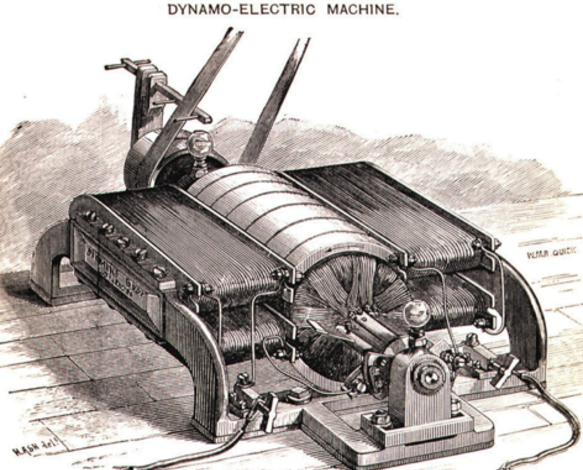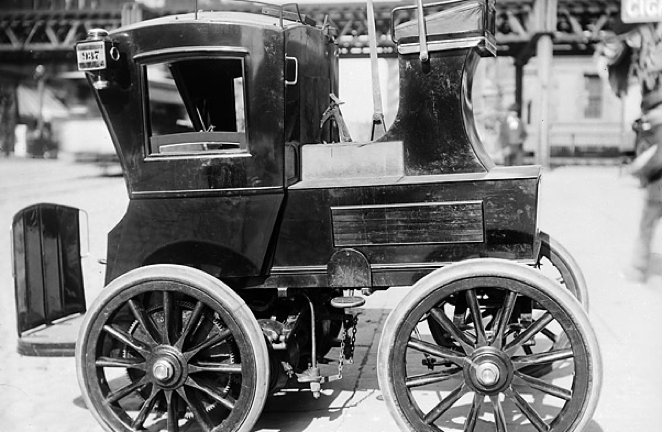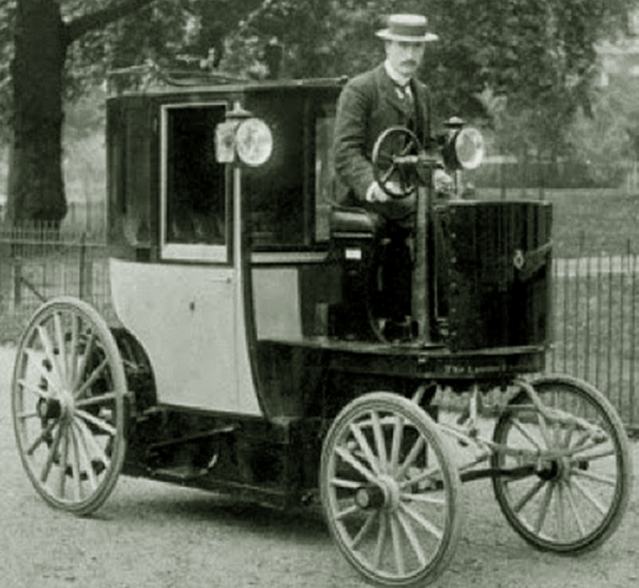Electric vehicle history
Electric vehicles have existed for longer than most people think. They long pre-date petrol and diesel. This electric vehicle history by Collyn Rivers is an overview.

The first dc electric motor (1866). Pic: Siemens UK.
The electric battery was invented by Allessandro Volta in 1800. In 1820, Christian Oersted showed electricity could produce a magnetic field. William Sturgeon, (in 1825) invented the electromagnet. Inventors worldwide sought to build an electric motor. They used two main approaches. These were: rotating, or reciprocating (i.e. like early steam engines).
In 1834, Moritz Jacobi invented the first (realistically powerful) electric motor. By 1838 it was improved. It propelled a 14-passenger boat. Meanwhile (1835), Sibrandus Stratingh and Christopher Becker developed an electric motor. It drove a small model carriage. The first electric motor patent was granted to USA’s Thomas Davenport. Many US sources credit Davenport as ‘inventing’ the electric car. It was, however, only a small model. It had negligible power. In 1866, Werner von Siemens developed the basic DC motor. It was this that enabled the first electric cars. DC motors are used to this day.
Electric vehicles were also hampered by lack of stored energy. The only realistic source required constantly supplied diluted acid. These ‘batteries’ were like today’s fuel cells. They combined hydrogen and oxygen to produce electricity. Such batteries worked. There is no record, however, of their powering electric vehicles.
The first lead-acid batteries
In 1859, Gaston Plante developed practical lead-acid batteries. They were bulky and heavy. Nevertheless, they made electric vehicles practical. Their first known usage (1897) was in New York’s electrically-powered taxis.

The first electric powered taxi – New York late 1890s. Pic: taxifarefinder.com
Electric cars’ original acceptance was thus near the end of the 1800s. Most were quieter and smoother than early petrol-fueled cars. Electric cars started instantly. They needed no ‘warming. No gear changing was required. There were even hybrids. In 1916, the Woods Motor Vehicle Company developed a car with both petrol and electrical engines. See Electric Vehicles – Hybrids.
The electric vehicle market was primarily the USA. There was, however, some usage in Europe. London had electrically-powered taxis from 1897. They became known as ‘Hummingbirds’ – due their curious sound.
 A London Hummingbird electric taxi – in use from 1897 for many years. They were designed by Walter Bersey.
A London Hummingbird electric taxi – in use from 1897 for many years. They were designed by Walter Bersey.
End of an era
Electric vehicles of that era lacked adequate control technology. This limited speed to about 30 km/h (about 19 mph).
By 1920 or so, road structures (particularly the USA’s) had massively increased. This was particularly inter-city. This required a vehicle range beyond that from batteries. These, however, remained similar in weight and size as 80 years before. Moreover, recharging facilities were inadequate beyond urban areas.
Meanwhile petroleum became increasingly plentiful. This enabled it to power vehicles cheaper and further than electrically. Furthermore, mass production made them affordable. The result was Henry Ford’s (1908) mass-produced model-T. It killed sales of electric cars. Thereon, electric vehicles were used only where limited range was required. It was nearly 40 years before electric cars re-appeared.
In the late 1950s, Henney Coachworks and Exide Batteries developed an electrically-powered Renault Dauphine. It attracted some sales. It could not, however, compete in price with conventional cars. Production ceased in 1961.
General Motors EV1
In 1990 California’s Air Resources Board briefly re-ignited interest in electric cars. Its mandate required U.S. major vehicle makers to have 2% of their products totally emissions-free if used in California. This resulted in General Motors producing its EV1. It was an electric-ony car.
Early EV1s had 16.5–18.7 kWh lead-acid batteries. Later EV1s had 26.4 kWh Nickel Metal Hydride (NiMH) batteries. The car was produced from 1996 to 1999. It was the first mass-produced and purpose-designed electric vehicle of the modern era.
Usage was by leasing only. Customers liked the EV1, but General Motors saw electric vehicles as unprofitable. It sought to cease production. In 2002 EV1 usage was ceased. General Motors repossessed all of them. Most were crushed. A few were given to museums, but with deactivated motors. The Smithsonian Institution has the only intact EV1.
Major US car makers then legally questioned California’s emissions requirement. This resulted in relaxed obligations. That, in turn, enabled developing and producing low emissions vehicles. These included natural gas and hybrid engines, but not (then) electric-only.

The General Motors EV1. Pic: Wikipedia
The right concept at the wrong time
The electric car (and truck) back then was the right concept. But at the wrong time. It awaited control technology, and lighter and smaller batteries.
Control technology then improved dramatically. That of rechargeable batteries, however, did not. Moreover, the size, weight and energy stored in lead-acid batteries remained much as 100 years before.
In 1996, the University of Texas conceived the lithium battery. These store three to four times the energy as lead-acid batteries the same size and weight. They charge quickly and can release huge amounts of energy over a short time.
Now (late 2020), lithium batteries enable electric-only cars to travel 350-550 km (about 220-345 miles) between charges. This is still borderline. It is inevitable, however it is inevitable that battery technology will advance. One thousand kilometres (625 miles) is now seen as feasible. Moreover, so too are electric off-road vehicles.
Further information
It is feasible to use home and other solar (with or without grid-connect) to charge electric cars. For details on using solar to charge electric cars click here. Furthermore, articles on all aspects of electrics cars are being progressively published on this website. Moreover, these will include ongoing details of technology and charging.
The Electric Vehicle Series
This is a part of a series of articles about the history and technology involved in electric vehicles.




